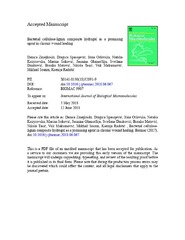Приказ основних података о документу
Bacterial cellulose-lignin composite hydrogel as a promising agent in chronic wound healing
| dc.creator | Zmejkoski, Danica | |
| dc.creator | Spasojević, Dragica | |
| dc.creator | Orlovska, Irina | |
| dc.creator | Kozyrovska, Natalia | |
| dc.creator | Soković, Marina | |
| dc.creator | Glamočlija, Jasmina | |
| dc.creator | Dmitrović, Svetlana | |
| dc.creator | Matović, Branko | |
| dc.creator | Tasić, Nikola | |
| dc.creator | Maksimović, Vuk | |
| dc.creator | Sosnin, Mikhail | |
| dc.creator | Radotić, Ksenija | |
| dc.date.accessioned | 2022-04-05T15:15:36Z | |
| dc.date.issued | 2018 | |
| dc.identifier.issn | 0141-8130 | |
| dc.identifier.uri | http://rimsi.imsi.bg.ac.rs/handle/123456789/1157 | |
| dc.description.abstract | Lignins and lignin-derived compounds are known to have antibacterial properties. The wound healing agents in the form of dressings produce faster skin repair and decrease pain in patients. In order to create an efficient antimicrobial agent in the form of dressing in the treatment of chronic wounds, a composite hydrogel of bacterial cellulose (BC) and dehydrogenative polymer of coniferyl alcohol (DHP), BC-DHP, was designed. Novel composite showed inhibitory or bactericidal effects against selected pathogenic bacteria, including clinically isolated ones. The highest release rate of DHP was in the first hour, while after 24 h there was still slow release of small amounts of DHP from BC-DHP during 72 h monitoring. High-performance liquid chromatography coupled with mass-spectrometry showed that BC-DHP releases DHP oligomers, which are proposed to be antimicrobially active DHP fractions. Scanning electron microscopy and atomic force microscopy micrographs proved a dose-dependent interaction of DHP with BC, which resulted in a decrease of the pore number and size in the cellulose membrane. The Fourier-transform infrared absorption spectra of the BC-DHP showed that DHP was partly bound to the BC matrix. The swelling and crystallinity degree were dose-dependent. All obtained results confirmed BC-DHP composite as a promising hydrogel for wounds healing. | en |
| dc.publisher | Elsevier, Amsterdam | |
| dc.relation | National Academy of Sciences of Ukraine [47/2015-2016] | |
| dc.relation | info:eu-repo/grantAgreement/MESTD/Integrated and Interdisciplinary Research (IIR or III)/45012/RS// | |
| dc.relation | info:eu-repo/grantAgreement/MESTD/Basic Research (BR or ON)/173017/RS// | |
| dc.relation | info:eu-repo/grantAgreement/MESTD/Integrated and Interdisciplinary Research (IIR or III)/45007/RS// | |
| dc.relation | info:eu-repo/grantAgreement/MESTD/Basic Research (BR or ON)/173040/RS// | |
| dc.relation | info:eu-repo/grantAgreement/MESTD/Basic Research (BR or ON)/173032/RS// | |
| dc.rights | embargoedAccess | |
| dc.rights.uri | https://creativecommons.org/licenses/by-nc-nd/4.0/ | |
| dc.source | International Journal of Biological Macromolecules | |
| dc.subject | Lignin model polymer | en |
| dc.subject | Bacterial cellulose | en |
| dc.subject | Antimicrobial activity | en |
| dc.title | Bacterial cellulose-lignin composite hydrogel as a promising agent in chronic wound healing | en |
| dc.type | article | |
| dc.rights.license | BY-NC-ND | |
| dc.citation.epage | 503 | |
| dc.citation.other | 118: 494-503 | |
| dc.citation.rank | aM21 | |
| dc.citation.spage | 494 | |
| dc.citation.volume | 118 | |
| dc.description.other | This is the peered review of the paper: Zmejkoski, D., Spasojević, D., Orlovska, I., Kozyrovska, N., Soković, M., Glamoclija, J., Dmitrović, S., Matović, B., Tasić, N., Maksimović, V., Sosnin, M.,& Radotić, K.. (2018). Bacterial cellulose-lignin composite hydrogel as a promising agent in chronic wound healing. in International Journal of Biological Macromolecules Elsevier, Amsterdam., 118, 494-503. [https://doi.org/10.1016/j.ijbiomac.2018.06.067 conv_590] | |
| dc.identifier.doi | 10.1016/j.ijbiomac.2018.06.067 | |
| dc.identifier.fulltext | http://rimsi.imsi.bg.ac.rs/bitstream/id/134/1154.pdf | |
| dc.identifier.pmid | 29909035 | |
| dc.identifier.scopus | 2-s2.0-85049108073 | |
| dc.identifier.wos | 000445170200057 | |
| dc.type.version | acceptedVersion |

